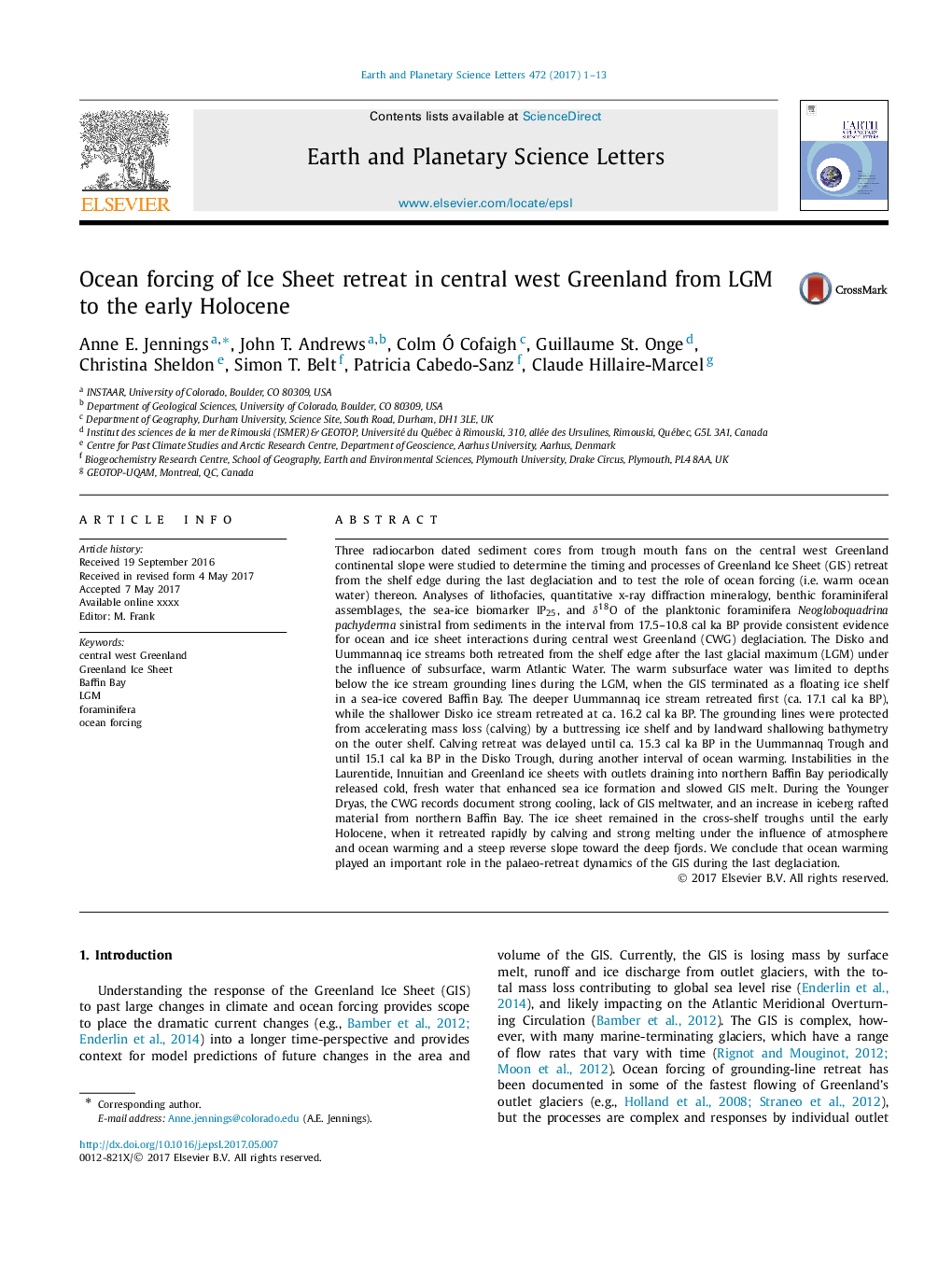| کد مقاله | کد نشریه | سال انتشار | مقاله انگلیسی | نسخه تمام متن |
|---|---|---|---|---|
| 5779494 | 1634684 | 2017 | 13 صفحه PDF | دانلود رایگان |
عنوان انگلیسی مقاله ISI
Ocean forcing of Ice Sheet retreat in central west Greenland from LGM to the early Holocene
دانلود مقاله + سفارش ترجمه
دانلود مقاله ISI انگلیسی
رایگان برای ایرانیان
موضوعات مرتبط
مهندسی و علوم پایه
علوم زمین و سیارات
علوم زمین و سیاره ای (عمومی)
پیش نمایش صفحه اول مقاله

چکیده انگلیسی
Three radiocarbon dated sediment cores from trough mouth fans on the central west Greenland continental slope were studied to determine the timing and processes of Greenland Ice Sheet (GIS) retreat from the shelf edge during the last deglaciation and to test the role of ocean forcing (i.e. warm ocean water) thereon. Analyses of lithofacies, quantitative x-ray diffraction mineralogy, benthic foraminiferal assemblages, the sea-ice biomarker IP25, and δ18O of the planktonic foraminifera Neogloboquadrina pachyderma sinistral from sediments in the interval from 17.5-10.8 cal ka BP provide consistent evidence for ocean and ice sheet interactions during central west Greenland (CWG) deglaciation. The Disko and Uummannaq ice streams both retreated from the shelf edge after the last glacial maximum (LGM) under the influence of subsurface, warm Atlantic Water. The warm subsurface water was limited to depths below the ice stream grounding lines during the LGM, when the GIS terminated as a floating ice shelf in a sea-ice covered Baffin Bay. The deeper Uummannaq ice stream retreated first (ca. 17.1 cal ka BP), while the shallower Disko ice stream retreated at ca. 16.2 cal ka BP. The grounding lines were protected from accelerating mass loss (calving) by a buttressing ice shelf and by landward shallowing bathymetry on the outer shelf. Calving retreat was delayed until ca. 15.3 cal ka BP in the Uummannaq Trough and until 15.1 cal ka BP in the Disko Trough, during another interval of ocean warming. Instabilities in the Laurentide, Innuitian and Greenland ice sheets with outlets draining into northern Baffin Bay periodically released cold, fresh water that enhanced sea ice formation and slowed GIS melt. During the Younger Dryas, the CWG records document strong cooling, lack of GIS meltwater, and an increase in iceberg rafted material from northern Baffin Bay. The ice sheet remained in the cross-shelf troughs until the early Holocene, when it retreated rapidly by calving and strong melting under the influence of atmosphere and ocean warming and a steep reverse slope toward the deep fjords. We conclude that ocean warming played an important role in the palaeo-retreat dynamics of the GIS during the last deglaciation.
ناشر
Database: Elsevier - ScienceDirect (ساینس دایرکت)
Journal: Earth and Planetary Science Letters - Volume 472, 15 August 2017, Pages 1-13
Journal: Earth and Planetary Science Letters - Volume 472, 15 August 2017, Pages 1-13
نویسندگان
Anne E. Jennings, John T. Andrews, Colm à Cofaigh, Guillaume St. Onge, Christina Sheldon, Simon T. Belt, Patricia Cabedo-Sanz, Claude Hillaire-Marcel,